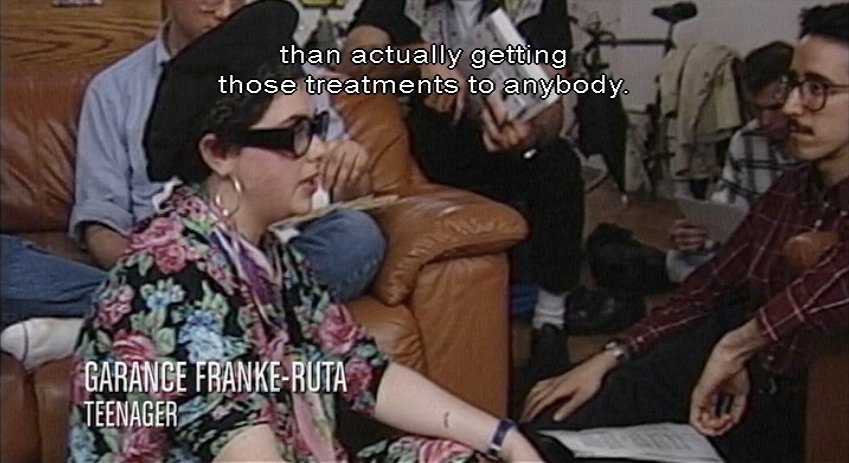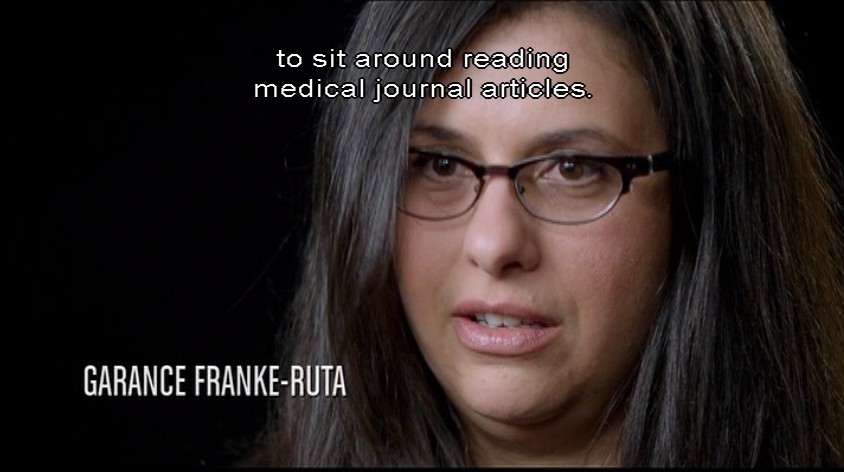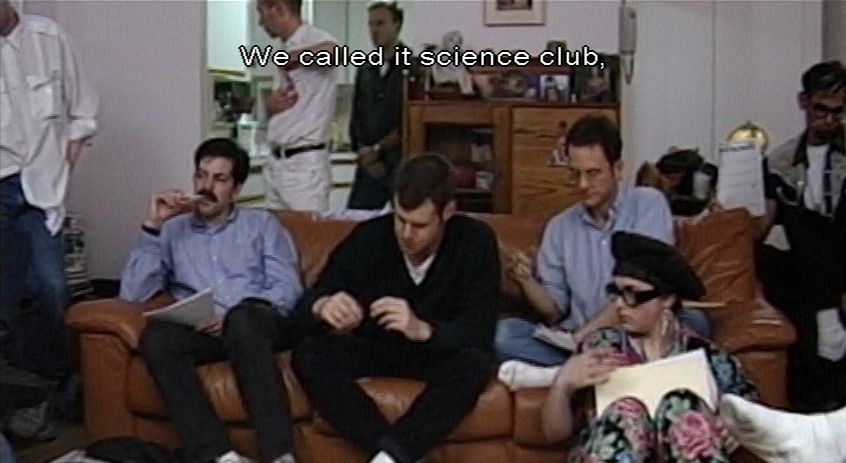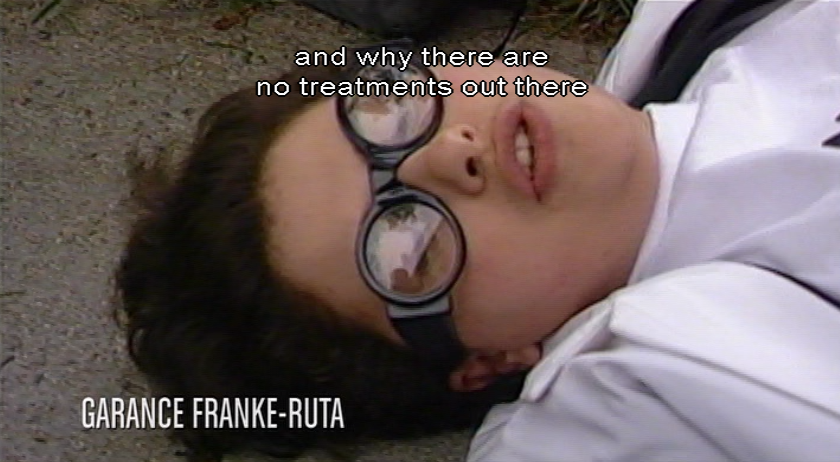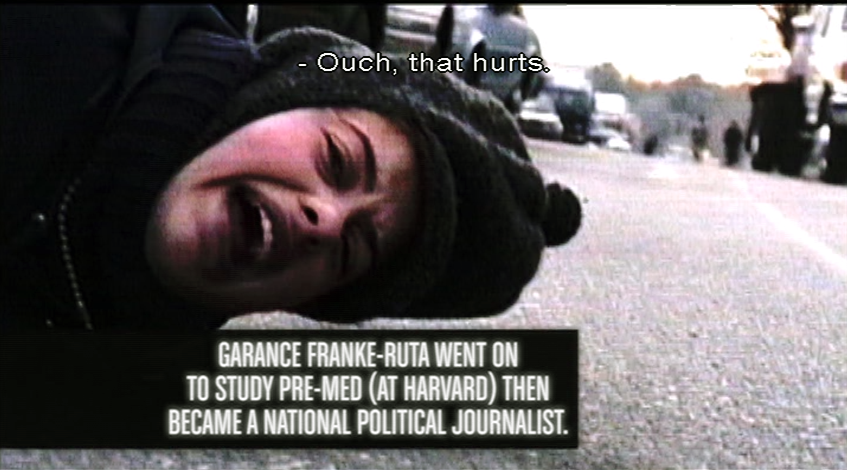Sarah Schulman, who is right only half the time and who lies about gay men, is at it again. Rather following the pattern of her other activities, in which Israel is viewed as the gay problem in the Middle East while Muslims, Islam, sharia, Palestine, and Palestinians are not, Schulman commits the lie that How to Survive a Plague intentionally pinkwashed nonwhites and women from ACT UP’s history.
- What did you think of How to Survive a Plague? There seemed to be a certain whitewashing of history going on.
Well, we call it “The Five White People Who Saved the World” – that’s our nickname for it. And those white people are very busy, because apparently they’re always saving everything all the time. Everywhere you go, you see them.
Jim Hubbard, the director of United in Anger: A History of ACT UP, and David France did a public debate. It was co-sponsored by Visual AIDS and you can watch it on YouTube and it’s really, really fascinating. At one point they open up for questions, and the first question to David is: “Why do you have no women or people of color in the film?” And he says, well, I wanted to focus on wealthy white men because they had the time to devote to activism.
Now, as a person who has interviewed 168 surviving members of ACT UP New York, I can tell you that’s not historically correct. People in ACT UP gave their entire lives to ACT UP. All different kinds of people from every class and background would report in our interviews that they were at ACT UP five nights a week, that their entire life was ACT UP. And that had nothing to do with how much money you had. And the second thing he said was that these men went to good universities and so they were able to understand the science. That is absurd. The audience almost started laughing. One of the best experts on the science of AIDS in ACT UP was Garance Franke-Ruta, who was 19. We all sat there and realized that this man knows nothing about ACT UP.
She makes these statements in the same interview in which she excoriates Dallas Buyers Club as “the opposite of the truth… straight people [as] the heroes of AIDS.”
At 56:25 in that recorded interview, the moderator reads out a question from Twitter (and it isn’t the first one by any definition): “David: Where are all the women and people of colour in your show?” Here’s what David France really said.
My decision to tell the story about AIDS treatment activism and this small group and their involvement with the NIH and the FDA and with pharma in this research limited the number of people whose stories I told to those whose stories I told. Two of them are women – two of the five or six characters are women. And one is Garance. And the question about who was Garance and what she brought to it can be asked about just about everybody else in the film. I picked them up in 1987, and with the exception of Peter Staley, whose backstory I give, you don’t really know much about these people except what they’re confronting at the moment, kind of on a daily basis.
The Treatment & Data Committee of ACT UP – first of all, ACT UP was, especially in the early years, was predominantly white gay-male grouping of people just trying to save their lives. And as people organized into various committees, that became the work that they focussed on. If I were to tell the story of the Media Committee, for example – I just saw somebody posted up a picture of all the members of the Media Committee, and it was, you know, 25 white men on the Media Committee. [Man in audience laughs] Well, you should see the picture, and you’d have to agree with me about that.
He means this picture from the Facebook, credited by Jay Blotcher as “Photo taken by Bill Bytsura in the ACT UP Workspace on Ninth Ave.”:
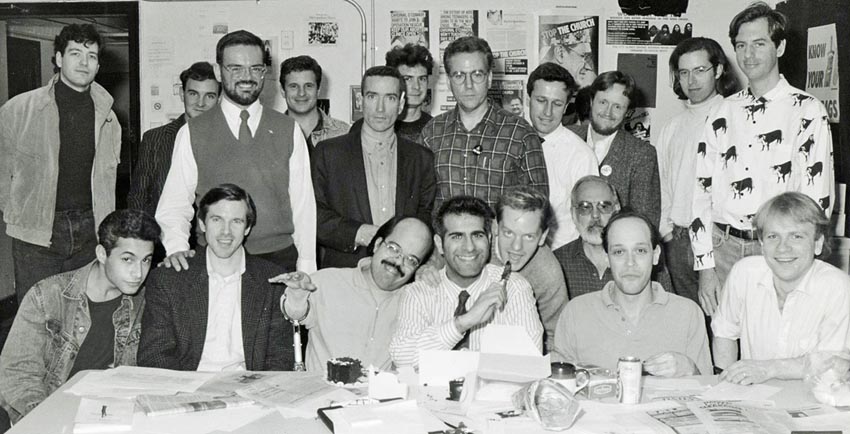
But what I decided to focus on was this group of people in Treatment & Data, the committee that was working so assiduously in the area of challenging science and ultimately forcing their way into dialogue with scientists. And those people are the people whose stories I told. And I knew from the onset that it wasn’t representative of the larger organization, both in background – a lot of the people in the Treatment & Data group came from quite privileged backgrounds. They had some Ivy League degrees among them. And they were able to, maybe more than people in other committees, able to work full-time for no pay for years to get this – to kind of further their political work. So it was a very unique group of people within that, and that’s whose stories I told.
Now, there are several junctures in the film where the issue of race and the issue of gender in the world of treatment is addressed – and both times by white gay men, who talk about the problems with the research establishment and the problems with the inclusion in trials. And that was in the archival footage that they address it. And I let them address it and let them say that this was in fact a huge problem in the way science was being conducted and the way research was being conducted, because research was an essential way to get medicine at a time when no medicine was available or approved. And so by virtue of the story that I carved out of it, it created – it found this cast of characters who were there on the ground. And so that’s the story I’ve told.
As you can see, Schulman has put her weight behind the opposite of the truth.
Besides, Franke-Ruta makes all sorts of appearances in How to Survive a Plague. Here are just a few – and these aren’t even all of the appearances in which her name is Chyroned.
Interestingly, the moderator in the above interview immediately asks “Jim, do you want to respond to that in terms of your film, too?” “No. Why don’t we have another question?” Hubbard says. I wonder if this is because Hubbard knows the actual truth, and because United in Anger (q.v.), which Schulman does not mention she coproduced, features Maxine Wolfe blowing a hole in the rewriting of history that men ran the place. Wolfe explicitly takes that stereotype to task and also describes how a couple of guys worked for years on women’s issues with no clear benefit to themselves.
I asked Garance Franke-Ruta about all this, obviously. She now writes for Yahoo News (bafflingly) and had to ask “our media people” before she could get back to me. How very un-activist. At any rate, if she is somehow unshackled and allowed to talk about her own life, I will report what she said.
In the meantime, no one but Schulman is responsible for her reputation as a lying sack of shit when it comes to gay men.
